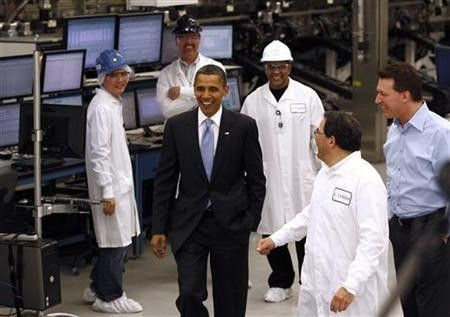Solar company that Obama visited will shut down

Solar start-up Solyndra LLC, succumbing to pressure from lower-cost Chinese rivals, said it has suspended operations and plans to file for bankruptcy, 15 months after President Barack Obama visited a company factory that was to be expanded with the help of a federal loan guarantee.
The Chapter 11 filing, expected next week, will make Solyndra the third U.S. solar company to seek bankruptcy protection in the last month. Former Wall Street high flyer Evergreen Solar Inc filed for Chapter 11 two weeks ago, followed four days later by SpectraWatt Inc, a private company that was backed by Intel Corp.
Representative Henry Waxman of the House Committee on Energy and Commerce said the bankruptcies are unfortunate warnings that the United States is in danger of losing its leadership position in the clean energy economy of the future ... We should be doing everything possible to ensure the United States does not cede the renewable energy market to China and other countries.
In a press release on Wednesday, Solyndra said it could not compete with bigger overseas rivals. Earlier this year, cuts to generous solar subsidies in No. 2 market Italy stalled development of solar projects and led to a global glut of solar panels that sparked a 25 percent drop in prices.
Even industry heavyweights such as China's Suntech Power Holdings Co Ltd and U.S.-based First Solar Inc are struggling with dwindling profits, while small, up-and-coming solar companies are finding it increasingly difficult to stay afloat.
Solyndra said it was evaluating options, including a sale of the business and licensing its copper indium gallium selenide (CIGS) technology.
About 1,100 employees are being laid off immediately, it said in a statement.
A company spokesman said the bankruptcy filing would likely come early next week in Delaware.
SWIMMING UPSTREAM
Solyndra simply could not compete with Chinese firms that have received billions of dollars in low-cost loans from state banks and have access to a well developed domestic supply chain for solar manufacturing, GTM Research analyst Shyam Mehta said. The company's relatively unproven CIGS technology was another key reason for its demise, he added.
Solyndra has been swimming upstream ever since it entered the market, Mehta said.
The announcement is the latest in a series of disappointments for Solyndra, whose fall from grace has been tracked closely because it received a $535 million loan guarantee from the Department of Energy in 2009.
The company also made headlines in May 2010 when Obama paid a visit to the company's Fremont, California, factory.
Solyndra was the first company to receive a loan guarantee under an advanced clean energy program created in 2005. The Energy Department came under criticism last year when the company postponed plans to expand the Fremont factory, cut jobs and withdrew plans for an initial public offering.
At the time, U.S. firms were just beginning to smart from the rapid influx of cheap solar panels from China.
In July, a congressional panel voted to subpoena White House documents related to Solyndra's loan guarantee. Republicans on the House Energy and Commerce subcommittee said they want to ensure that funds appropriated for the loan guarantee program were properly invested.
Solyndra also received some $1 billion in venture capital funds from investors including CMEA Ventures, Argonaut Ventures, Madrone Partners, Redpoint Ventures, funds affiliated with RockPort Capital Partners, and U.S. Venture Partners.
Prior to Solyndra, Evergreen Solar was the most high-profile U.S. solar company to collapse. Evergreen was once at the forefront of U.S. renewable energy technology and had planned to produce its solar wafers in Massachusetts. Ultimately, even a plan to shift manufacturing to Asia could not save it.
Solyndra had revenue of $140 million in 2010 and had said it planned to produce 300 megawatts of solar panels this year.
© Copyright Thomson Reuters 2024. All rights reserved.




















